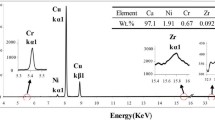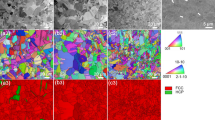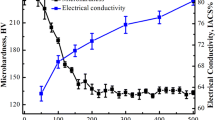Abstract
Mechanical properties and formation of nano-sized grains in Cu and Cu−Fe−P alloys by the accumulative roll bonding (ARB) process were investigated. Nano-sized grains were successfully obtained in OFC and PMC-90 alloys by the ARB process after the third cycle. Once the 200 nm grains formed, further reduction in the grain size was not observed up to 8 ARB process cycles. For both alloys, the tensile strength values increased drastically in the initial stage of the ARB process. The tensile strength values of both alloys tended to saturate after the third ARB process cycle. The tensile elongation value greatly decreased by 1 cycle of the ARB process due to the strain hardening. After the third cycle of the ARB process, each alloy showed a gradual increase in tensile elongation due to the dynamic recovery. For PMC-90 alloy, the strength value was higher than that of OFC due to addition of the alloying elements. With increased annealing temperature, the nanosized grains tended to grow in OFC at 150°C, and after annealing at 200°C, coarse grains formed. On the other hand, in PMC-90 alloy, there was no grain growth up to 250°C due to the alloying elements (Fe, P).
Similar content being viewed by others
References
V. M. Segal,Mater. Sci. Eng. A 197, 157 (1995).
R. Z. Valiev, A. V. Korznikov, and R. R. Mulyukov,Mater. Sci. Eng. A 186, 141 (1993).
Y. Iwahashi, Z. Horita, M. Nemoto, and T. G. Langdon,Acta metal. 45, 4733 (1997).
Y. Saito, N. Tsuji, H. Utsunomiya, and R. G. Hong,Scripta mater. 39, 1221 (1998).
S. H. Lee, C. H. Lee, and C. Y. Lim,Mater. Sci. Forum,449–452, 161 (2004).
H. W. Kim, S. B. Kang, N. Tsuji, and Y. Minamino,Acta metall. 53, 1737 (2005).
Z. Horita, D. J. Smith, M. Furukawa, M. Nemoto, R. Z. Valiev, and T. G. Langdon,J. Mater. Res. 11, 1880 (1996).
K. Ohishi, Z. Horita, D. J. Smith, M. Furukawa, R. Z. Valiev, M. Nemoto, and T. G. Langdon,J. Mater. Res. 14, 4200 (1999).
N. Tsuji, T. Toyoda, Y. Minamino, Y. Koizumi, M. Kiritani, M. Komatsu,Mater. Sci. Eng. A 350, 108 (2003).
S. S. Kim, M. J. Haynes, and R. P. Gangloff,Mater. Sci. Eng. A 203, 256 (1995).
Author information
Authors and Affiliations
Corresponding author
Additional information
This article is based on a presentation made in the symposium “The 7th KIM-JIM Symposium & the 3rd International Symposium on nanostructured Materials Technology”, held at KINTEX, Ilsan, Korea, October 27–28, 2005 under auspices of the Korean Institute of Metals and Materials, The Japan Institute of Metals and Center for Nanostructured Materials Materials Technology.
Rights and permissions
About this article
Cite this article
Lim, CY., Han, SZ. & Lee, SH. Formation of nano-sized grains in Cu and Cu−Fe−P alloys by accumulative roll bonding process. Met. Mater. Int. 12, 225–230 (2006). https://doi.org/10.1007/BF03027535
Issue Date:
DOI: https://doi.org/10.1007/BF03027535




